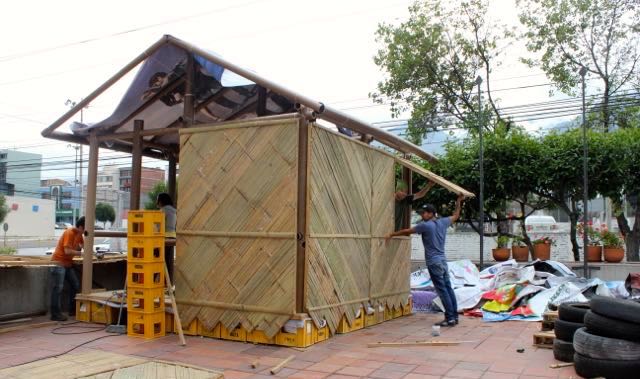A personal toolbox
Shigeru Ban is an expert in paper-tube structures. The Japanese architect uses this unusual material to construct many worldwide disaster-relief projects as well as different types of housing, emergency shelters, and all sorts of public buildings. With the release of the Carta Collection in Zürich, his paper expertise is now being applied to the serial production of furniture. While Ban’s activities are highly versatile, his principles remain clearly delineated.
Shigeru Ban is a modest man. Dressed in a black suit with stand-up collar (designed by his mother), he is in Zürich to inaugurate the launch of his furniture series. He speaks about his work in a quiet flow of words. The basic points of his task as an architect have been clearly defined in his architecture for many years. “We produce too much waste”, he pronounces soberly, showing examples of materials and projects that translate the principle of not throwing things away. The Japanese architect is considered a master of sustainability and recycling, but he would never mention those complex terms or explain his own work as being influenced by ‘environmental issues issues’. Instead, he states that his personal conviction is to implement a human attitude in his projects. His commitment to architecture is a deeply societal one and this did not change after he won architecture’s highest accolade, the Pritzker Prize, in 2014. “After receiving the award, I had many offers from developers,but I didn’t accept any of the projects”, he says. Among all the buildings that he and his team have completed over the years, the disaster-relief projects and paper-tube constructions are two main constants. Together with students from the Voluntary Architect’s Network (VAN), an NGO he founded in 1995 in Tokyo, Ban has been building refugee shelters, temporary housing, nurseries, and even a cathedral, for the victims of earthquakes, tsunamis, and other catastrophes – in Rwanda, Turkey, China, and Haiti. Most of these projects utilise paper tubes.
The story of his paper structures began in 1986, soon after Shigeru Ban established his office in Tokyo having returned to the city following his studies in New York and Los Angeles. In order to develop the design of Alvar Aalto’s exhibition in Tokyo, he was in search of a low-budget material. “Unfortunately, using wood, as Alvar Aalto did, was much too expensive”, he recounts. “In looking for an alternative, the idea arose to use paper tubes. At the time, we made all our sketches and drawings on paper, including fax paper, and once the roll was finished, the tubes were left. The moment had come to use the tubes instead of throwing them away! I found out that they were made of recycled paper and were inexpensive, and they were also much stronger than I expected. The paper-tube mission proved complicated, as permission was needed in order to use it as a construction material for permanent architecture. However, its use was not an issue in regard to temporary structures, so Ban made several such buildings. And then he devised an opportunity that would enable him to obtain the permit for using paper tube as a structural material. “Although I am not the kind of person who enjoys weekends, I started to design my own weekend home. It was a good occasion to use the paper tubes – I realised that nobody would ask me to design a house out of this material if there was not an existing example. So I built it as a prototype and spent one year making tests. I went through all the approval stages required by the government and finally received a permit for the first permanent paper-structure building.” The walls of the house were constructed using 120 cm diameter tubes, and the furniture was made of the same material but in much smaller diameters. “I have used my dining chairs for more than 20 years already and have never replaced them”, Ban exclaims. “Because of the natural properties of the material, it forms to the body over time. The more they’re used, the more comfortable they become.” This same chair, along with a stool, a bench, a lounge chair, and a chaise longue, now form part of the Carta Collection produced by Swiss manufacturer wb form. “I love my chairs because they are made of paper tubes. You can get this material anywhere in the world; we even found it in Rwanda.”
In 1995, Ban was commissioned by the UNHCR as a consultant for refugee shelters. “I was shocked when I saw the UN-supplied camps in Rwanda. They were so messy. The shelters were just not good enough; people were freezing-cold during the rainy season. So I suggested that the paper-tube design replace the use of local wood.” (A fact unknown at that moment is that the use of timber was causing serious desertification, thus rendering the idea even more relevant). The architect remembers the details of the many disaster regions he has been to. He always travels to those places by himself within a couple of days after the catastrophe hits, and tries to find out more about the particular needs of the victims – often those belonging to minority groups who are ignored by the official aid organisations. With his NGO in Tokyo, Ban develops the prototypes along with local students, building shelters and training the survivors in how to build these themselves. All the details and construction manuals for the disaster- relief projects are published in Ban’s book, in addition to documentation on the testing data. The paper-tube projects are open source and can be reproduced almost anywhere. Shigeru Ban says with pride: “I am happy that my design is copied.”
Text: Sandra Hofmeister

